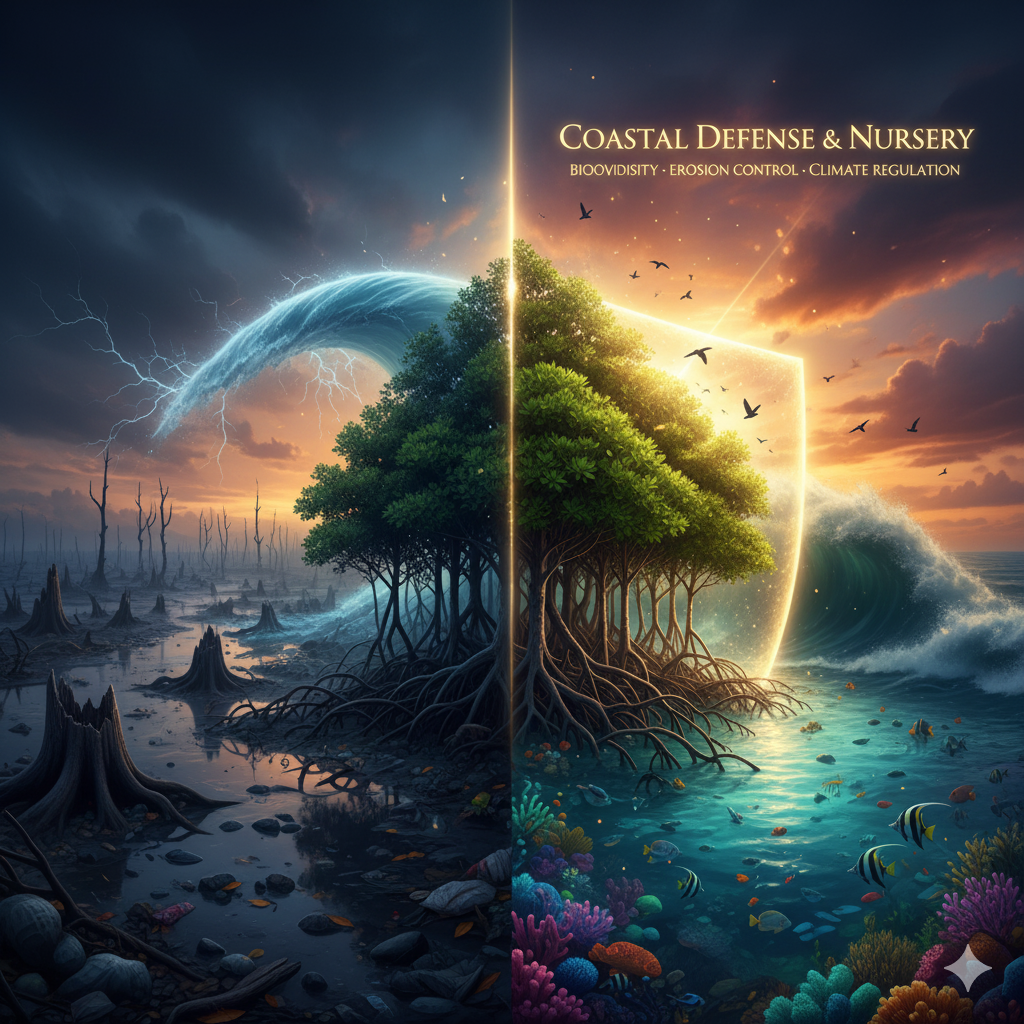Introduction
Mangroves are one of the most vital ecosystems in the tropical and subtropical coastal zones. They consist of salt-tolerant plant species such as Rhizophora, Avicennia, Sonneratia, and Bruguiera, thriving in intertidal regions where rivers meet the sea. Despite covering less than 1% of tropical forests globally, mangroves provide disproportionate ecological, economic, and social benefits. They stabilize shorelines, protect against storms and tsunamis, sequester carbon, and serve as nurseries for countless marine species.
However, mangrove ecosystems are under severe threat due to both natural and anthropogenic pressures. According to the FAO, the world has lost nearly one-third of its mangrove forests in the past 50 years. In India, the total mangrove cover stands at about 4,992 sq km (ISFR 2021), which is only 0.15% of the country’s geographical area. Although some states like West Bengal, Gujarat, and Maharashtra show improvement in cover, others continue to lose these critical ecosystems.
This essay discusses the causes of mangrove depletion and their importance in maintaining coastal ecology, supported with examples and case studies.
1. Understanding Mangroves: Distribution and Characteristics
- Geographical Distribution:
Found in more than 120 countries, major mangrove belts occur in Southeast Asia, South Asia, East Africa, and the Caribbean. In India, significant mangroves occur in the Sundarbans (West Bengal), Mahanadi delta (Odisha), Godavari-Krishna delta (Andhra Pradesh), Pichavaram (Tamil Nadu), Gulf of Kachchh and Kachchh (Gujarat), and Mumbai-Thane creek (Maharashtra). - Unique Features:
- Halophytic plants (salt-tolerant).
- Specialized root systems: pneumatophores for respiration in waterlogged soils.
- Viviparous germination (seed germinates while attached to the parent).
- High carbon sequestration potential, often called “blue carbon ecosystems.”
2. Causes of Depletion of Mangroves
Mangrove destruction is the result of multiple, interconnected factors that can be categorized as anthropogenic (human-induced) and natural causes.
2.1 Anthropogenic Causes
- Coastal Development and Urbanization
- Large-scale clearing of mangroves for ports, harbors, airports, housing, and industrial complexes.
- Example: Expansion of Mumbai’s urban infrastructure has led to large-scale mangrove destruction along the Thane creek and Navi Mumbai region.
- Large-scale clearing of mangroves for ports, harbors, airports, housing, and industrial complexes.
- Aquaculture and Shrimp Farming
- Conversion of mangrove areas into shrimp farms and aquaculture ponds is one of the leading causes of loss in Southeast Asia and India.
- Example: Andhra Pradesh and Tamil Nadu have witnessed significant mangrove loss due to commercial shrimp farming.
- Conversion of mangrove areas into shrimp farms and aquaculture ponds is one of the leading causes of loss in Southeast Asia and India.
- Industrialization and Pollution
- Discharge of effluents, oil spills, and chemical pollutants degrade mangrove health.
- Example: The Gulf of Kachchh mangroves face continuous pressure from thermal power plants, refineries, and industrial discharges.
- Discharge of effluents, oil spills, and chemical pollutants degrade mangrove health.
- Deforestation and Overexploitation
- Mangroves are harvested for fuelwood, timber, tannins, fodder, and honey. Unsustainable extraction depletes forests.
- Example: In Sundarbans, over-dependence of local communities on wood and honey harvesting puts pressure on ecosystems.
- Mangroves are harvested for fuelwood, timber, tannins, fodder, and honey. Unsustainable extraction depletes forests.
- Agricultural Expansion
- Conversion of mangrove wetlands into paddy fields or cash crop plantations reduces mangrove cover.
- Example: In Kerala, mangrove destruction is linked to paddy cultivation in low-lying wetlands.
- Conversion of mangrove wetlands into paddy fields or cash crop plantations reduces mangrove cover.
- Tourism and Recreational Activities
- Construction of hotels, resorts, and recreational facilities in coastal belts leads to mangrove destruction.
- Example: Goa’s mangroves face degradation due to tourism-related land reclamation.
- Construction of hotels, resorts, and recreational facilities in coastal belts leads to mangrove destruction.
- Infrastructure Projects
- Highway construction, coastal embankments, and reclamation projects cut off tidal flows, affecting mangrove health.
2.2 Natural Causes
- Cyclones and Storm Surges
- Cyclones uproot mangroves and increase soil salinity, delaying regeneration.
- Example: Cyclone Amphan (2020) destroyed vast tracts of mangroves in the Sundarbans.
- Cyclones uproot mangroves and increase soil salinity, delaying regeneration.
- Sea-Level Rise
- Global warming-induced rise in sea levels submerges mangrove habitats and alters salinity.
- Global warming-induced rise in sea levels submerges mangrove habitats and alters salinity.
- Coastal Erosion
- Natural erosion of coastlines leads to shrinking mangrove belts.
- Natural erosion of coastlines leads to shrinking mangrove belts.
- Changes in Hydrology
- Damming of rivers reduces freshwater flow into deltas, increasing salinity beyond tolerance limits.
- Example: Reduced freshwater inflow in the Godavari delta due to upstream dams affects mangrove regeneration.
- Damming of rivers reduces freshwater flow into deltas, increasing salinity beyond tolerance limits.
- Climate Change
- Rising temperatures, erratic rainfall, and shifting monsoon patterns alter mangrove ecology.
- Coral reef loss also indirectly affects mangroves by disturbing sediment balance and tidal flows.
- Rising temperatures, erratic rainfall, and shifting monsoon patterns alter mangrove ecology.
3. Importance of Mangroves in Maintaining Coastal Ecology
Despite depletion, mangroves remain invaluable for ecological stability. Their importance can be highlighted under environmental, economic, and social aspects.
3.1 Ecological Importance
- Coastal Protection
- Act as natural barriers against cyclones, tsunamis, and storm surges.
- Example: During the 2004 Indian Ocean Tsunami, villages in Tamil Nadu protected by mangroves experienced less damage than unprotected areas.
- Act as natural barriers against cyclones, tsunamis, and storm surges.
- Prevention of Coastal Erosion
- Dense root networks stabilize soil and trap sediments, preventing shoreline erosion.
- Dense root networks stabilize soil and trap sediments, preventing shoreline erosion.
- Carbon Sequestration
- Mangroves absorb up to 4–5 times more carbon than terrestrial forests, storing it in biomass and sediments (blue carbon).
- This plays a crucial role in mitigating climate change.
- Mangroves absorb up to 4–5 times more carbon than terrestrial forests, storing it in biomass and sediments (blue carbon).
- Nursery Grounds for Marine Species
- Provide breeding and feeding grounds for fish, crabs, prawns, and mollusks.
- Essential for maintaining marine biodiversity and sustaining fisheries.
- Provide breeding and feeding grounds for fish, crabs, prawns, and mollusks.
- Water Filtration
- Roots filter pollutants, heavy metals, and excess nutrients from water, improving coastal water quality.
- Roots filter pollutants, heavy metals, and excess nutrients from water, improving coastal water quality.
- Support for Migratory Birds and Wildlife
- Mangroves serve as habitats for diverse species including tigers (Sundarbans), saltwater crocodiles, and migratory birds.
3.2 Socio-Economic Importance
- Livelihood Support
- Provide wood, honey, tannins, fodder, and fish resources to local communities.
- Provide wood, honey, tannins, fodder, and fish resources to local communities.
- Fisheries and Aquaculture
- Sustain commercial fisheries and shrimp industries by serving as nurseries.
- Sustain commercial fisheries and shrimp industries by serving as nurseries.
- Tourism and Ecotourism
- Scenic mangrove belts (like Pichavaram in Tamil Nadu) attract tourists, promoting eco-tourism and income.
- Scenic mangrove belts (like Pichavaram in Tamil Nadu) attract tourists, promoting eco-tourism and income.
- Medicinal Value
- Some mangrove species have medicinal properties used in traditional healing systems.
- Some mangrove species have medicinal properties used in traditional healing systems.
- Disaster Mitigation
- By reducing the energy of waves and storm surges, mangroves reduce loss of human lives and infrastructure.
4. Case Studies
- Sundarbans (India-Bangladesh): The largest mangrove forest in the world, home to the Royal Bengal Tiger. Faces threats from rising sea levels, cyclones, and population pressure.
- Pichavaram (Tamil Nadu, India): Well-preserved mangroves known for eco-tourism, highlight the potential of sustainable conservation.
- Gulf of Kachchh (Gujarat, India): Industrial expansion and pollution threaten unique mangrove ecosystems.
- Mekong Delta (Vietnam): Large-scale conversion to shrimp farms has destroyed thousands of hectares of mangroves.
5. Global and National Conservation Efforts
5.1 Global Initiatives
- Ramsar Convention on Wetlands (1971): Recognizes mangroves as critical wetlands.
- UNEP Mangrove Restoration Projects.
- Blue Carbon Initiatives for carbon sequestration credits.
5.2 Indian Initiatives
- National Mangrove Committee (1976) under MoEFCC.
- National Mangrove and Coral Reef Committee (NMCREE) for policy support.
- Coastal Regulation Zone (CRZ) Notification, 2011 restricting activities in mangrove areas.
- Mangrove Afforestation Projects in states like West Bengal, Gujarat, and Maharashtra.
- Community Participation in states like Odisha, where local groups manage mangrove restoration.
6. Challenges in Mangrove Conservation
- Lack of awareness and community participation.
- Conflicting interests between development and conservation.
- Inadequate enforcement of laws.
- Climate change impacts beyond human control.
7. Way Forward
- Strengthening Legal Frameworks: Strict enforcement of CRZ regulations.
- Community Involvement: Promoting eco-tourism, sustainable harvesting, and participatory management.
- Scientific Management: Use of GIS and remote sensing for monitoring.
- Restoration Projects: Large-scale afforestation of degraded mangrove areas.
- Integration with Climate Policies: Recognizing mangroves as blue carbon sinks under climate agreements.
- Education and Awareness: Incorporating mangrove conservation into environmental education.
Conclusion
Mangroves are lifelines for coastal ecology and human survival. They provide multiple ecosystem services, from biodiversity conservation and carbon storage to storm protection and livelihood support. Yet, anthropogenic exploitation, combined with natural disasters and climate change, has led to their alarming depletion.
Protecting mangroves is not only a matter of conserving biodiversity but also ensuring resilience against climate change and safeguarding coastal populations. A balanced approach that integrates conservation, sustainable use, and community participation is essential. Ultimately, mangroves symbolize the delicate interconnection between humans and nature — their survival is inseparable from ours.




